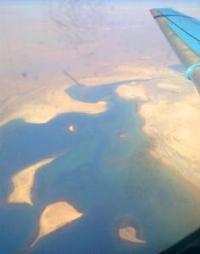You are here
Khazar Sea.

Destinations and routes of the Khorezm.
“Sea Khazar. This sea is not connected to any of the seas on the surface of the earth, neither by mixing, nor by means of communication, except that it enters it from the river of the Rus, known as Itil, and it (the river Itil. - K. K.) is connected by a branch leading from it to the strait, [which] emerges from the land of Byzantium, with the sea surrounding. And if a person travels around this sea, he will return to the place from which he started [his way] without interference, and will not cross [the road] anything but the river (Itil. - T.K), [which] flows into it and spreads in it "
Translation by TM Kalinina on: Ibn Haukal 1938-1939. S. 388.
The Great Silk Road and Khorezm.
The Khazar Sea is also Tabaristan, Dzhurdzhan and Abeskun. This is a large, wide sea that does not connect with other seas. It is also called Khorasan and Jilan, and some are sometimes called the Khorasan Circle. In Persian, it is called Zarah-Akfuda or Akfuda-Daria (Blue Sea).
Aristotle calls him Irkan, and some people call him sometimes the Khorezm Sea, but this is not true, because the Khorezm (Aral) Sea is completely different and will be told about it in its place. On the shore of this sea is Bab al-Abwab, i.e. Derbend, as we have already said about it.
On the east side, the Mugan and Tabaristan mountains and the Dzhurdzhan mountain approach the sea. It stretches all the way to Dihistan, where the [city] of Abaskun is located, then turns east towards the land of the Turks, and north towards the Khazar country.
Many large rivers flow into this sea, including the Kura, Arak and Itil (Volga). It is a salty sea and there is no ebb or flow in it. The sea is dark, its bottom is clay, not the same as the Kulsum (Red) Sea or the Persian Sea, where you can see the bottom and see the white stones there.
No gemstones or pearls are extracted from the Khazar Sea. no coral and nothing else useful except fish. On this sea, merchants from Muslim countries float to the Khazar country, as well as to the countries lying between Arran and Gilan. Dzhurdzhanom and Tabaristanom.
In this sea there is not a single inhabited, cultivated island, as it is, for example, found in the Persian, Rumsky (Mediterranean) and other seas, but there are islands covered with forest, with water, but deserted. These islands include Siah Kukh.
Not far from the [confluence] of the Kura River into the sea, there is another island on which the forest grows, there is water, and where they collect marin. On this island, ships deliver pack animals and let them graze so that they fatten fat. There is an island on the sea named al-Rusiyya and other small islands.
If you go to the right of Abaskun in the direction of the Khazars, then you will not find a single village on the coast, except for the place called Dikhistan, which is fifty farces from Abaskun, and some kind of building (pier?) Jutting into the sea, behind which ships are sheltered during storms.
Many people come here from all sides and are engaged in fishing and, moreover, there is fresh water. Besides that, I don't know anything. To the left of Abaskun, well-cultivated lands continuously stretch toward the Khazars, and if you go in this direction, you will have to go through the lands of Dzhurdzhan, Tabaristan, Deylem, Gilyan, Mukan, Shirvan, Muscat and Bab al-Abvab.
From Bab al-Abwab to Samandar is four days' journey, from Samandar to the River Itil seven days in the desert. On the side of Sieyah-Kukha, on the sea, there are shoals, which pose a great danger to ships, which break if the wind blows them to the shoals.
And if the ships crash, you will not collect anything because of the Turks who capture these ships and return nothing to the owners. It is said that the circumference of this sea is equal to 1500 Farsham, and the diameter - 100 Farsham.
However, Allah knows best!
Authority:
(translated by Z. M. Buniyatov and P. K. Zhoze). The text is based on publications: Yakut al-Hamawi. Mu'jam al-Buldan. (Information about Azerbaijan). Hamdallah Qazvini. Nuzhat al-kulub. (Materials on Azerbaijan). Baku. Elm 1983
Photos
Alexander Petrov.







